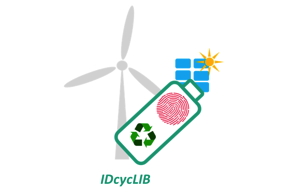Home > Press > A materials passport for greener batteries: Research project is investigating more environmentally friendly manufacturing and recycling processes
 |
| IDcycLIB-Logo |
Abstract:
Efficient battery systems are increasingly being used in cars, tools, bicycles and as stationary energy storage units. At the same time, the requirements placed on these batteries continue to rise, not only in terms of energy density and cost, but also in terms of environmentally friendly manufacturing and recycling. Reusing batteries, in particular, is often difficult and not yet economically viable. Researchers are hoping to find solutions to these problems in a new project, which has received funding of over 4.5 million euros from the Federal Ministry of Education and Research (BMBF). One of the research partners is Friedrich-Alexander-Universitt Erlangen-Nrnberg (FAU): With a type of battery passport, chemists at the University aim to store the information required for recycling the battery directly inside the battery itself.
A materials passport for greener batteries: Research project is investigating more environmentally friendly manufacturing and recycling processes
Nuremberg, Germany | Posted on October 15th, 2021
The aim of the BMBF-funded project IDcycLIB (Innovationsplattform einer grnen, detektierbaren und direkt recycelbaren Lithium-Ionen-Batterie Innovation platform for green, detectable and directly recyclable lithium-ion batteries) is to manufacture recyclable and environmentally-friendly electrodes and subsequently regain materials from batteries via direct recycling. Until now, cell and battery concepts have not been designed to provide information about the chemicals in the cell, the condition of the battery or other characteristics that would enable them to be reused. This is precisely where the FAU research team led by Prof. Dr. Karl Mandel, Professorship of Inorganic Chemistry, would like to make its contribution to the research consortium: they are working to equip the cells with markers. These tiny markers are comprised of magnetic nano building blocks. When these markers are combined at varying ratios, a code is generated containing information, for example about the chemistry of the cell. This code varies from battery to battery depending on the materials they contain, and can act like a unique battery passport. The markers enable the constituent parts of batteries to be separated according to type using a process called electrohydraulic fragmentation, which another research team in the consortium is investigating in detail.
Another research topic of IDcycLIB is the subsequent selective separation of the valuable materials in batteries using automated centrifuge technology. If the active materials (the chemical substances) that store the energy in the battery are of the right quality, they are reused to make new batteries. If the quality is unsatisfactory, they can still be reused in batteries, but first they have to undergo further chemical and physical processing. A comparison of the electrochemical output of the cells manufactured from reclaimed and new materials will be used to demonstrate the efficiency of the IDcycLIB process. At the same time, the recycling process for residues from industrial manufacturing will be tested. As well as carrying out experiments, the project groups will develop software tools for evaluating sustainability and for controlling the digitally-recorded material flows.
About the research project
The IDcycLIB project consortium, reference number 03XP0393C, consists of ten funded partners and two associated partners, and has received a total of more than 6.9 million euros of funding, 4.5 million euros of which has been provided by the Federal Ministry of Education and Research (BMBF). In addition to FAU, the other members of the consortium include Fraunhofer Institute for Silicate Research ISC in Wrzburg, with which FAU has started collaborating closely since Prof. Mandel was appointed to FAU. IDcycLIB is the first large joint project in which both institutions are involved.
####
For more information, please click here
Contacts:
Katrin Piecha
Friedrich-Alexander-Universitt Erlangen-Nrnberg
Office: 49-913-185-70218
Expert Contact
Prof. Dr. Karl Mandel
Friedrich-Alexander Universitt Erlangen-Nrnberg
Office: +49 9131 85 27396
Copyright © Friedrich-Alexander-Universitt Erlangen-Nrnberg
If you have a comment, please Contact us.
Issuers of news releases, not 7th Wave, Inc. or Nanotechnology Now, are solely responsible for the accuracy of the content.
![]() Further information about research into magnetic microparticles is available here:
Further information about research into magnetic microparticles is available here:
![]() Link to Professorship of Inorganic Chemistry:
Link to Professorship of Inorganic Chemistry:
News and information
Possible Futures
![]() Molecular Sciences Software Institute receives $15 million grant from National Science Foundation October 15th, 2021
Molecular Sciences Software Institute receives $15 million grant from National Science Foundation October 15th, 2021
Announcements
![]() Molecular Sciences Software Institute receives $15 million grant from National Science Foundation October 15th, 2021
Molecular Sciences Software Institute receives $15 million grant from National Science Foundation October 15th, 2021
Interviews/Book Reviews/Essays/Reports/Podcasts/Journals/White papers/Posters
Battery Technology/Capacitors/Generators/Piezoelectrics/Thermoelectrics/Energy storage
![]() Stretching the capacity of flexible energy storage September 10th, 2021
Stretching the capacity of flexible energy storage September 10th, 2021
![]() Polymer electrolytes for all-solid-state batteries without dead zones August 20th, 2021
Polymer electrolytes for all-solid-state batteries without dead zones August 20th, 2021
![]() Researchers discover a new inorganic material with lowest thermal conductivity ever reported July 16th, 2021
Researchers discover a new inorganic material with lowest thermal conductivity ever reported July 16th, 2021










